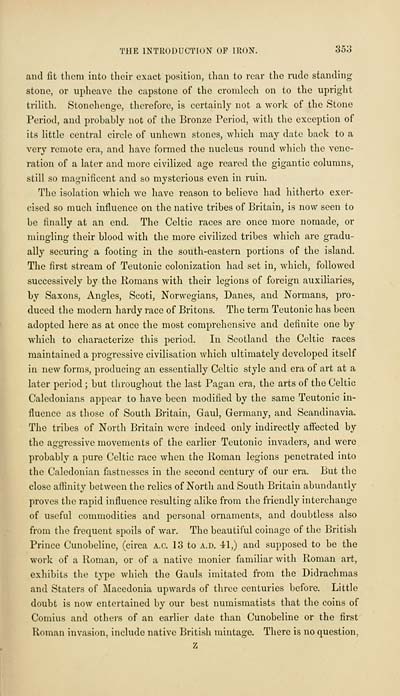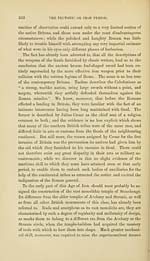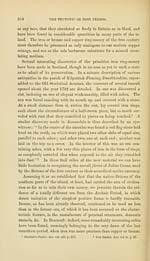Download files
Complete book:
Individual page:
Thumbnail gallery: Grid view | List view

THE INTRODUCTION OP IRON. 35.3
and fit tlicm into their exact position, than to rear the rude standing
stone, or upheave the capstone of the cromlech on to the upright
trilith. Stonehenge, therefore, is certainly not a work of the Stone
Period, and probably not of the Bronze Period, with the exception of
its little central circle of unhewn stones, which may date back to a
very remote era, and have formed the nucleus round which the vene-
ration of a later and more civilized age reared the gigantic columns,
still so magnificent and so mysterious even in ruin.
The isolation which we have reason to believe had hitlierto exer-
cised so much influence on the native tribes of Britain, is now seen to
be finally at an end. The Celtic races are once more nomade, or
mingling their blood with the more civilized tribes which are gradu-
ally securing a footing in the south-eastern portions of the island.
The first stream of Teutonic colonization had set in, which, followed
successively by the Romans with their legions of foreign auxiliaries,
by Saxons, Angles, Scoti, Norwegians, Danes, and Normans, pro-
duced the modern hardy race of Britons. The term Teutonic has been
adopted here as at once the most comprehensive and definite one by
which to characterize this period. In Scotland the Celtic races
maintained a progressive civilisation which ultimately developed itself
in new forms, producing an essentially Celtic style and era of art at a
later period ; but throughout the last Pagan era, the arts of the Celtic
Caledonians appear to have been modified by the same Teutonic in-
fluence as those of South Britain, Gaul, Germany, and Scandinavia.
The tribes of North Britain were indeed only indirectly aftected by
the aggressive movements of the earlier Teutonic invaders, and were
probably a pure Celtic race when the Roman legions penetrated into
the Caledonian fastnesses in the second century of our era. But the
close affinity between the relics of North and South Britain abundantly
proves the rapid influence resulting alike from the friendly interchange
of useful commodities and personal ornaments, and doubtless also
from the frequent spoils of war. The beautiful coinage of the British
Prince Cunobeline, (circa a.c. 13 to a.d. 41,) and supposed to be the
work of a Roman, or of a native monier familiar with Roman art,
exhibits the type which the Gauls imitated from the Didrachmas
and Staters of Macedonia upwards of three centuries before. Little
doubt is now entertained by our best numismatists that the coins of
Comius and others of an earlier date than Cunobeline or the first
Roman invasion, include native British mintage. There is no question,
Z
and fit tlicm into their exact position, than to rear the rude standing
stone, or upheave the capstone of the cromlech on to the upright
trilith. Stonehenge, therefore, is certainly not a work of the Stone
Period, and probably not of the Bronze Period, with the exception of
its little central circle of unhewn stones, which may date back to a
very remote era, and have formed the nucleus round which the vene-
ration of a later and more civilized age reared the gigantic columns,
still so magnificent and so mysterious even in ruin.
The isolation which we have reason to believe had hitlierto exer-
cised so much influence on the native tribes of Britain, is now seen to
be finally at an end. The Celtic races are once more nomade, or
mingling their blood with the more civilized tribes which are gradu-
ally securing a footing in the south-eastern portions of the island.
The first stream of Teutonic colonization had set in, which, followed
successively by the Romans with their legions of foreign auxiliaries,
by Saxons, Angles, Scoti, Norwegians, Danes, and Normans, pro-
duced the modern hardy race of Britons. The term Teutonic has been
adopted here as at once the most comprehensive and definite one by
which to characterize this period. In Scotland the Celtic races
maintained a progressive civilisation which ultimately developed itself
in new forms, producing an essentially Celtic style and era of art at a
later period ; but throughout the last Pagan era, the arts of the Celtic
Caledonians appear to have been modified by the same Teutonic in-
fluence as those of South Britain, Gaul, Germany, and Scandinavia.
The tribes of North Britain were indeed only indirectly aftected by
the aggressive movements of the earlier Teutonic invaders, and were
probably a pure Celtic race when the Roman legions penetrated into
the Caledonian fastnesses in the second century of our era. But the
close affinity between the relics of North and South Britain abundantly
proves the rapid influence resulting alike from the friendly interchange
of useful commodities and personal ornaments, and doubtless also
from the frequent spoils of war. The beautiful coinage of the British
Prince Cunobeline, (circa a.c. 13 to a.d. 41,) and supposed to be the
work of a Roman, or of a native monier familiar with Roman art,
exhibits the type which the Gauls imitated from the Didrachmas
and Staters of Macedonia upwards of three centuries before. Little
doubt is now entertained by our best numismatists that the coins of
Comius and others of an earlier date than Cunobeline or the first
Roman invasion, include native British mintage. There is no question,
Z
Set display mode to: Large image | Transcription
Images and transcriptions on this page, including medium image downloads, may be used under the Creative Commons Attribution 4.0 International Licence unless otherwise stated. ![]()
| Early Gaelic Book Collections > J. F. Campbell Collection > Archaeology and prehistoric annals of Scotland > (395) |
|---|
| Permanent URL | https://digital.nls.uk/78376034 |
|---|
| Description | Volumes from a collection of 610 books rich in Highland folklore, Ossianic literature and other Celtic subjects. Many of the books annotated by John Francis Campbell of Islay, who assembled the collection. |
|---|
| Description | Selected items from five 'Special and Named Printed Collections'. Includes books in Gaelic and other Celtic languages, works about the Gaels, their languages, literature, culture and history. |
|---|

